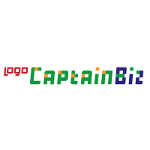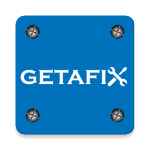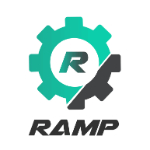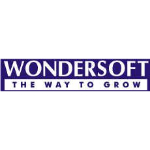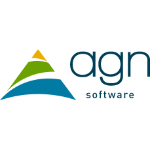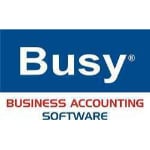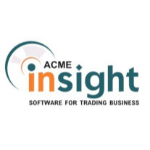List of Best Automobile Industry Software
Showing 10 of 43 productsCaptainBiz is a software designed to streamline your business operations and elevate your success. With its user-friendly interface features, CaptainBiz empowers businesses of all sizes to efficiently manage tasks, increase productivity, and achieve...Read CaptainBiz Reviews
GetAFix is an innovative software that aims to simplify and streamline the process of managing repairs and maintenance for businesses. By providing a user-friendly platform, GetAFix allows customers to easily submit requests, track progress, and comm...Read GetAFix Reviews
Alikeapps is a software that streamlines and simplifies business operations. With its user-friendly interface features, Alikeapps empowers businesses to stay organized, streamline processes, and boost productivity. Say goodbye to complicated solution...Read Alikeapps Reviews
RAMP Auto Repair, where our team of experienced mechanics are dedicated to providing top-notch services for all your automotive needs. With our state-of-the-art technology and unmatched expertise, we are committed to delivering efficient solutions to...Read RAMP Auto Repair Reviews
the world of Wondersoft Shopaid, an innovative solution tailored for the modern retail industry. Designed with efficiency and ease-of-use in mind, Wondersoft Shopaid aims to revolutionize the way businesses manage their operations, from inventory and...Read Wondersoft Shopaid Reviews
Infor LN is a robust and powerful enterprise resource planning (ERP) software designed to streamline business processes and drive growth. With its user-friendly interface features, Infor LN empowers businesses to make informed decisions, improve effi...Read Infor LN Reviews
Autowin is a software designed to streamline your daily tasks and boost your productivity. With Autowin, you can say goodbye to manual processes and hello to efficiency and precision. Leave the mundane tasks to Autowin and focus on what truly matters...Read Autowin Reviews
Busy Accounting Software is a solution for all your financial management needs. With its user-friendly interface features, Busy streamlines your accounting processes and helps you stay on top of your finances. Say goodbye to tedious tasks and hello t...Read Busy Accounting Software Reviews
ARI Auto Repair Software is a solution for streamlining and improving your auto repair shops operations. With ARI, you can easily manage appointments, inventory, invoicing, and more, allowing you to provide top-notch service to your customers while m...Read ARI Auto Repair Software Reviews
Acme Insight is a software designed to streamline and simplify business operations. With its powerful features and user-friendly interface, Acme Insight revolutionizes the way businesses manage their processes, saving time, effort, and resources. Sta...Read Acme Insight Reviews
- What Is Automobile Industry Software?
- Top Reasons Why Businesses Need Automobile Industry Software?
- What Are the Top Key Features of Automobile Industry Software?
- What Are the Top Benefits of Automobile Industry Software?
- What Are the Steps to Choose the Right Automobile Industry Software?
- What Are the Types of Automobile Industry Software for Different Industries?
- What Are the Technology Trends for Best Automobile Industry Software?
- What Are the Deployment Options for Automobile Industry Software?
What Is Automobile Industry Software?
The automobile industry software refers to specialized computer programs that play a crucial role in several sectors within the automotive industry.
These applications enhance manufacturing processes by utilizing tools such as computer-aided design (CAD) software for vehicle design and manufacturing execution systems (MES) for effective production management.
In the domains of sales and customer service, professionals are responsible for the effective management of inventory, the cultivation of client connections through the utilization of Customer Relationship Management (CRM) systems, and the optimization of dealership operations through the implementation of Dealer Management Systems (DMS).
Automotive industry software incorporates state-of-the-art technology, such as artificial intelligence (AI) and data analytics, which enable notable progressions in the realm of autonomous automobiles and electric cars.
In summary, it functions as the technical underpinning of the automobile sector, driving advancements, productivity, and improved consumer interactions.
Top Reasons Why Businesses Need Automobile Industry Software?
1. The automotive industry software approach to enhance operational efficiency involves the automation and streamlining of many operations, including but not limited to customer service, inventory management, and order fulfillment.
2. Automobile software approach to enhancing customer service is the utilization of various systems, such as computerized vehicle scheduling and maintenance reminders.
3. One way to improve pricing strategies is to monitor customer preferences and rival pricing.
4. The best automotive software strategy for enhancing efficiency and productivity within the service department is the implementation of automated procedures.
5. One potential strategy for enhancing customer retention and loyalty is the implementation of satisfaction surveys and other instruments for gathering consumer feedback.
6. One potential strategy for increasing sales of parts and accessories is to enhance the integration of vendor catalogs and inventory databases.
7. The automotive industry software area for improvement is the enhancement of service communication and coordination of vehicle service duties across different departments.
8. Automobile software improvement to consider is enhancing the management of inventory levels and the ordering process for parts and accessories from numerous suppliers.
9. One way to enhance the recall process is by implementing automated notifications and progress tracking, which can help streamline the overall procedure.
10. One potential avenue for enhancing financial reporting and forecasting is through the integration of accounting and inventory systems.
11. Automotive software is imperative to closely monitor key performance indicators (KPIs) and assess performance in relation to predetermined standards.
12. The best automotive software area for enhancement is the optimization of mechanics' scheduling in order to effectively cater to customers' needs and fulfill staffing requirements.
13. Automobile software strategy for enhancing contract negotiation and execution is to diligently monitor and evaluate warranty and service contracts.
14. Automotive industry software strategy to enhance customer service is to monitor and analyze client history and patterns in order to proactively anticipate their demands and customize services accordingly.
15. The objective of this analysis is to examine client input in order to find specific areas that require improvement and to guarantee customer happiness.
What Are the Top Key Features of Automobile Industry Software?
1. Automated Vehicle Tracking: The integration of location tracking and monitoring capabilities inside automotive software utilized in the automobile sector is vital to enhance fleet management practices.
2. Parts Tracking and Restocking: Automotive industry software enables enterprises to effectively monitor their inventory of parts and initiate the procurement of more parts as required.
3. Billing and Invoicing: Automotive corporations necessitate expeditious and precise generation of bills as well as efficient client billing management.
4. Service Scheduling: The functionality of automotive software should encompass the seamless facilitation of scheduling service checkups, maintenance tasks, and repair appointments with consumers.
5. Data Management: It is imperative for organizations to safely and accurately preserve all information pertaining to customers, vehicles, and employees.
6. Vehicle Maintenance Logging: In order to ensure precise service planning, automotive firms must maintain a comprehensive record of vehicle maintenance and repair histories.
7. Customer Relationship Management: The efficient management of client accounts and communication is a crucial aspect that automobile software should provide.
8. Business Intelligence: The automotive industry software utilized in automobiles should possess the capability to accumulate and analyze data in order to discern patterns and potential areas for growth, thereby acquiring valuable insights.
9. Vehicle Inspection: Automotive software to possess the capability to conduct vehicle inspections with efficiency and precision.
10. Access Control: The implementation of access control mechanisms and data security measures is crucial in automobile software to prohibit unauthorized access and safeguard sensitive information.
What Are the Top Benefits of Automobile Industry Software?
1. Improved efficiency: The implementation of automotive software has proven to enhance operational efficiency and precision through the optimization of several operations, including production tracking, inventory and order management, and customer service.
2. Increased Customer Satisfaction: The utilization of software for automobile facilitates the process of locating necessary components and services for clients, hence enhancing their overall satisfaction.
3. Cost Savings: The implementation of automobile the best automotive software has resulted in a reduction in manual processing time and associated costs, leading to significant time and cost savings.
4. Automated Reporting: The utilization of software in the automobile industry facilitates the automated generation of reports pertaining to production and operational data, hence streamlining the decision-making process.
5. Supplier and Parts Management: The utilization of software in the automobile industry streamlines the management of suppliers and parts, facilitating the supervision of product availability and the assurance of superior quality.
6. Automated Compliance: The software utilized in the automobile industry facilitates the automation of safety and compliance management processes, hence assisting organizations in maintaining compliance with prevailing industry rules.
7. Flexibility: The automotive software utilized in the automobile sector can be customized to cater to the unique requirements of organizations, enabling them to optimize their operational processes and leverage the most advanced technological advancements available.
What Are the Steps to Choose the Right Automobile Industry Software?
1. Identify your organization's objectives: Identify the objectives of your firm in the selection of a novel software for automobile industry. This encompasses comprehending the various categories of tasks that a company must undertake, evaluating the existing technological infrastructure, and assessing the available resources.
2. Evaluate options: Conduct a comprehensive investigation into different software platforms utilized in the automobile industry and ascertain the ones that exhibit the highest level of compatibility with your firm. This analysis aims to compare and contrast the functionality, cost, and compatibility with existing systems of various options.
3. Consult stakeholders: Engage in discussions with relevant stakeholders within your organization in order to obtain their perspectives and expertise over the most suitable software for automobiles. The insights and input provided by individuals' experiences and feedback can serve as valuable sources of information to guide the decision-making process.
4. Test and evaluate software: Conduct experiments with various software platforms in order to ascertain their user-friendliness and compatibility across several systems. This analysis aims to assess the quality of customer service and support options, payment alternatives, and additional features that contribute to the suitability of the program for an enterprise.
5. Finalize selection: Please proceed with your final selection and proceed with the purchase of the software that you have selected. It is important to consider that there may be a period of adaptation required for both you and your team to acclimate to the recently implemented system.
6. Plan and implement: Formulate a comprehensive strategy for the execution and delivery of training as required. Ensure continuous monitoring of progress and promptly handle any issues that may occur.
What Are the Types of Automobile Industry Software for Different Industries?
Various types of software are available for usage in different industries within the vehicle sector. The aforementioned program encompasses vehicle maintenance, fleet management, fuel management, parts management, computed tomography, and inventory management.
Vehicle maintenance software is a tool utilized in the car industry to enhance the efficiency of vehicle maintenance procedures. Its primary function is the systematic monitoring and recording of maintenance records for individual vehicles.
Fleet management software facilitates the systematic monitoring and documentation of essential vehicle data for fleet proprietors, encompassing mileage and fuel expenditures associated with the fleet.
Fuel management software is employed for the purpose of monitoring and regulating fuel usage and associated expenses pertaining to automobiles. Parts management software is utilized by specialists in the automobile industry to effectively monitor and manage the inventory of parts and supplies, with the primary objective of minimizing expenses.
The utilization of computed tomography software is employed in order to produce three-dimensional representations of the internal components of vehicles, mostly for the purpose of conducting inspections. Inventory management software is utilized for the purpose of effectively storing and monitoring the inventory of various components and resources that are now available.
What Are the Technology Trends for Best Automobile Industry Software?
In order to maintain competitiveness, it is imperative for the automobile industry software to align with the rapid changes in technology. The prevailing technological developments in the automotive industry software domain encompass:
1. Automotive Internet of Things (IoT): The utilization of real-time data by connected automobiles has the potential to enhance safety, navigation, performance, and customer experience through software advancements.
The implementation of Internet of Things (IoT) devices in the automotive industry will enable automakers to enhance software optimization for both present and forthcoming automobiles.
2. Artificial Intelligence (AI): The utilization of real-time data by connected automobiles has the potential to enhance safety, navigation, performance, and customer experience through software advancements.
The implementation of Internet of Things (IoT) devices in the automotive industry will enable automakers to enhance software optimization for both present and forthcoming automobiles.
3. Big data: Automobiles are equipped with cloud connectivity, enabling the transmission and storage of substantial volumes of data. The aforementioned data has the potential to be utilized in the development of predictive models pertaining to many aspects such as routing, safety, customer experience, and other relevant areas.
4. Advanced analytics: The integration of automotive data with data derived from many sources allows for a more holistic comprehension of customer behavior, driving patterns, and the functionalities present within the car.
The implementation of this approach will enable the customization of software and services to cater to the individual preferences and needs of each user.
5. Cloud-based functional safety: With the increasing dependence of vehicles on interconnected systems and sensors, the imperative to ensure safety has grown significantly. Cloud infrastructure and safety models will be employed to guarantee the software's security and dependability.
In general, the optimal software for the automotive sector should employ cutting-edge technology in order to deliver a secure, seamless, and pleasurable driving encounter. It is imperative for companies to possess knowledge about technical advancements and market trends in order to maintain a competitive edge.
What Are the Deployment Options for Automobile Industry Software?
The available deployment options for the best automotive software encompass on-premise deployment, cloud-based deployment, and hybrid deployment.
1. In the context of on-premise deployment, the software is installed within the physical confines of the automotive manufacturer's data center. This feature enables robust security measures and facilitates effective oversight of software upgrades and implementation processes.
Under this particular deployment strategy, the company assumes the responsibility for the maintenance and resolution of any technical issues that may arise.
2. Cloud-based deployment, on the other hand, entails the hosting of software on the internet by a third-party supplier. Selecting this option can be quite advantageous as the service provider assumes the responsibility of ensuring the continuous functionality of the software, as well as managing maintenance and upgrades.
3. A hybrid deployment entails the utilization of both on-premise and cloud-based installations inside a single system. This approach offers benefits to the firm as it allows for the utilization of advantages inherent in both models while only incurring costs for the specific resources utilized.
The selection of a deployment option should be contingent upon the level of control and security requirements of the company.
